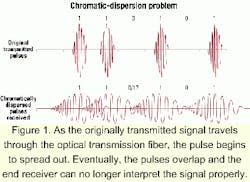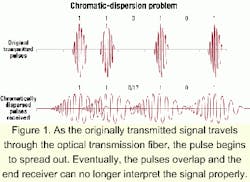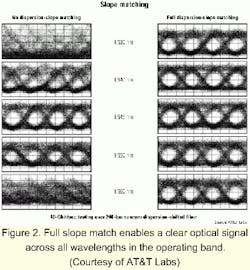Challenging the limits of chromatic dispersion
Overcoming the limitation posed by chromatic dispersion is a key challenge for long-haul carriers in their quest for the ultimate low-cost, high-capacity fiber-optic network.
YONGQIAN LIU, LaserComm Inc.
In today's competitive environment, telecommunications carriers are racing to meet spiraling bandwidth demand at the lowest possible cost. To achieve the minimal cost per bit per km, long-haul carriers are pushing their optical backbones to the limit, maximizing the capacity of the existing fiber plant and utilizing less equipment to send data over longer distances.
One of the key challenges holding long-haul carriers back in their quest for the ultimate low-cost, high-capacity optical network is chromatic dispersion. Chromatic dispersion poses enormous limitations to increasing channel counts, bit rates, and transmission distances and even enabling new operating bands. Effectively managing this dispersion across the entire operating band is one of the keys to opening capacity and dramatically reducing the equipment, engineering, and servicing costs of optical networks.
Chromatic dispersion is the natural spreading of optical data pulses as they travel through the transport fiber. This pulse-spreading occurs because the individual wavelengths that compose an optical pulse travel at slightly different speeds. Chromatic dispersion becomes a problem when the dispersed pulses begin to overlap, and the network receiver can no longer distinguish the "1"s from the "0"s (see Figure 1). The effect of chromatic dispersion is an intolerable increase in bit errors.
The problem of chromatic dispersion intensifies as carriers try to increase fiber capacity and extend the distance between regenerators to lower the cost threshold of their optical networks. One method of maximizing the fiber's capacity is to increase the number of DWDM channels transported over a single fiber, both in the C-band and, more recently, the L-band.However, greater channel density significantly magnifies the problem of chromatic dispersion as it raises the importance of dispersion slope. Dispersion slope is formed by the different rates of dispersion experienced by individual wavelengths across the operating band. If dispersion is not precisely corrected for every wavelength, the "left-over" dispersion accumulates, eventually reaching the system's tolerance limit for dispersion. Reaching the limit requires the pulse to be optically regenerated before it can travel any further. By eliminating residual dispersion at the edge of the operating band, precise dispersion-slope matching enables carriers to transmit data efficiently over all channels and increases the distance the pulse can travel before regeneration.
Another method of expanding the fiber's capacity is to increase data rates from 2.5 Gbits/sec to today's 10 Gbits/sec and tomorrow's 40 Gbits/sec. As modern optical networks take on higher data rates, the light blinks faster and optical pulses are closer together. Pulses at high data rates begin to overlap sooner as they experience chromatic dispersion.
With traditional 2.5-Gbit/sec networks, the pulses were transmitted far enough apart to allow them room to spread without causing a significant impact on the transmission system. However, at faster data rates, the transmission system's tolerance to chromatic dispersion is drastically reduced. When operating at 10 Gbits/sec, the system is 16 times less tolerant to dispersion than it was at 2.5 Gbits/sec; when operating at 40 Gbits/sec, the system is 256 times less tolerant to dispersion.
In addition to increasing the capacity of the optical network, carriers are working to eliminate costly electrical equipment and create an all-optical network. Here, too, chromatic dispersion is proving to be a limitation on performance. Currently, carriers are expanding the distance between optical-electrical-optical (OEO) regenerator sites from 600 km to ultra-long reaches of 1,000 to 5,000 km.Chromatic dispersion presents a problem to transmitting data farther, as dispersion accumulates at a linear rate along the transmission fiber. In other words, a system's tolerance for dispersion decreases as the distance increases. Any residual dispersion in an ultra-long-haul (ULH) network can significantly limit the distance a signal can travel without regeneration. As a result, dispersion is a major obstacle for ULH networks.
As noted, chromatic dispersion is clearly a significant limiting factor, as long-distance carriers increase bit rates to 10 and 40 Gbits/sec, expand to hundreds of channels, and boost optical link distances to thousands of kilometers. DWDM system manufacturers and carriers must overcome the barrier of chromatic dispersion. It will take a chromatic-dispersion management solution with the following characteristics to enable them to fully achieve these goals:
Precise dispersion and dispersion-slope management. Precise dispersion management is extremely critical as dispersion tolerances tighten. With bit rates and link distances on the rise, there is very little room for dispersion in the network. For example, while 2.5-Gbit/sec networks can tolerate up to 16,000 psec of dispersion, 10-Gbit/sec networks can tolerate only 1,000 psec of dispersion and 40-Gbit/sec systems can tolerate only 60 psec of dispersion. The ideal dispersion-management system must be able to provide precise dispersion management to meet these increasingly exacting tolerances.
The key to precise dispersion management is full dispersion-slope match. Full slope match means that the unique amount of positive dispersion experienced by each wavelength is countered with an equal amount of negative dispersion. With full slope match, each wavelength receives exactly the amount of dispersion correction it needs to eliminate its dispersion, yielding a net result of zero dispersion at the receiver end.
The need for accurate dispersion-slope management is even more profound for DWDM systems deployed on today's nonzero dispersion-shifted fiber (NZDSF), which inherently has a relatively steep slope. In some NZDSF, a channel at the high end of the C-band will experience three times more dispersion than a channel at the low end of the band. The precise matching of dispersion slope results in a clearly distinguishable optical signal for wavelengths across the entire operating band. When dispersion compensation without full slope matching is employed on the same optical link, signals quickly become unclear toward the edges of the band (see Figure 2).
Wideband continuous dispersion management. As carriers turn on more channels, the ideal dispersion-management solution must be continuous, providing dispersion correction for all channels, whether in the C-band or the emerging L-band. Continuous dispersion management is important because it provides the flexibility to add new channels and at the same time reduces nonlinearities, like dispersion ripple, that adversely affect the signal-to-noise ratio and limit the distance a signal can travel without regeneration.
High optical power tolerance. The ideal dispersion-management solution must be capable of handling high optical power without stimulating nonlinear effects. As networks migrate from long-haul to ultra-long-haul distances, individual optical com-ponents and modules must be able to tolerate higher levels of optical power. If components are ex-posed to more optical power than they were designed for, nonlinear effects are stimulated, negatively im-pacting overall system performance. A solution with high optical power capabilities allows optical networks to support faster bit rates, add optical add/drop devices, and increase transmission distances.
Greater utilization of existing fiber capacity and fewer OEO regenerators on the network allow carriers to benefit from tremendous cost savings. Millions of dollars in capital expenditures can be saved when carriers deploy a solution for chromatic dispersion that precisely manages dispersion and dispersion slope, offers wideband capabilities, and handles high optical power levels.
Employing a dispersion-management solution with precise slope matching and low noise generation allows for more optical channels to retain their clarity over much longer distances. Fewer regenerators are needed to reshape the optical pulse. Since the cost for a single re genera-tor accounts for a significant portion of the entire network cost, the elimination of just one regenerator site translates into substantial cost savings for carriers.
In addition, carriers can realize considerable savings, as fewer components will be needed, resulting in more space and lower installation costs. As an example, by extending the link length between regenerators from 600 km to 1,200 km, a dispersion-management solution can reduce total link costs by 30%. For a typical 40-channel DWDM system, the increase in distance translates into cost savings of about $4 million per link.
The relationship between regenerator cost savings and channel count means that as carriers turn on more channels, the potential for savings, in absolute dollar value, is even greater. With an average regenerator cost of approximately $100,000 per channel, a 30% cost reduction per link translates into about $16 million in savings for a 160-channel DWDM system.
A dispersion-management device capable of handling high optical power levels offers other potential cost savings. When more power can be launched into the dispersion-management device without stimulating nonlinearities, more power is available to support other all-optical devices. For example, the improved power budget can enable network designers to incorporate optical add/drop multiplexers into amplifier sites, thereby replacing very expensive back-to-back electrical terminals that convert optical signals into electrical signals for add/drop functions.
By supporting the higher power required to facilitate channel add/drops in the optical domain, a dispersion-management solution can deliver cost savings of more than 40% for a network designed with just three add/drop sites. For a 40-channel system, this all-optical approach translates into cost savings of about $10 million. The savings are even greater when more add/drop sites are involved or higher-channel-count systems are deployed.
To meet customer demand for bandwidth and remain competitive in the toughening telecommunications environment, carriers are looking to maximize their existing optical networks by sending more data-faster and further-at reduced cost. However, chromatic dispersion presents a major barrier to expanding network capacity as it drastically limits the speed, distance, and channel density of optical networks.
To overcome the limitations imposed by chromatic dispersion, carriers need a solution that precisely manages both dispersion and dispersion slope, corrects for all channels across the operating bands, and can handle high optical power input. Meeting these requirements, carriers will be able to increase bit rates to 10 and 40 Gbits/sec, expand to hundreds of channels, boost optical link distances to thousands of kilometers, and take one step further toward the goal of an all-optical network.
Yongqian Liu is a chief scientist at LaserComm Inc. (Plano, TX). He can be reached via the company's Website, www.lasercomm-inc.com.
To get the quickest response to your question, contact the appropriate person listed below.
Reprints, Bulletin Board
Kathleen McIntosh
Tel: (603) 891-9203
E-mail: [email protected]
Subscriptions, back issues
Michelle Blake
Tel: (603) 891-9360
E-mail: [email protected]
New Products, Calendar, People
Leah Gladu
Tel: (603) 891-9219
E-mail: [email protected]
News, features, letters
Stephen M. Hardy
Tel: (603) 891-9454
E-mail: [email protected]
Media kit, editorial calendar
Hilary Lloyd
Tel: (603) 891-9218
E-mail: [email protected]
Paid subscriptions
Omeda Customer Service
Tel: (847) 559-7520
E-mail: [email protected]


